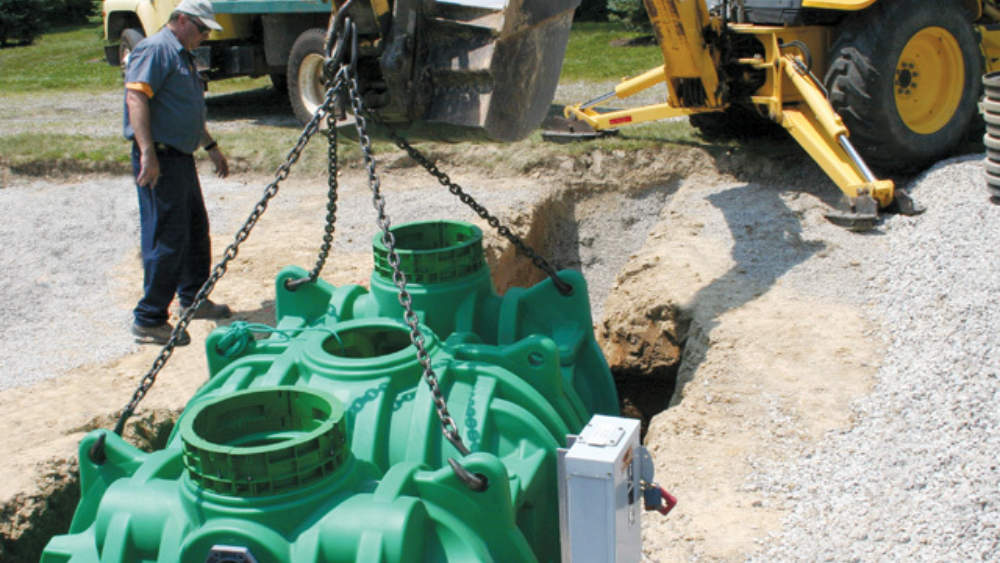Month: October 2018
A homeowner needed help choosing wastewater systems for a lakefront estate. Dervin Witmer, owner of Dig-It Excavating in Cassopolis, Michigan, recommended a Norweco residential wastewater treatment system.
The project involved tearing down an old cottage and building a new, larger, four-season home on a lot right beside a lake. The owners had two goals for their wastewater system.
“One was environmental: They wanted to keep the lake clean and not contribute to the algae problem. But they also wanted alternative technology because of the space they had available,” Witmer says.
When the home was first proposed to the county, the design called for a standard wastewater system. There was a 1,500-gallon septic tank, a 500-gallon dosing tank, and an 800-square-foot drainfield in a sand mound built up to give adequate separation from the 12-inch seasonal water table.
Then came the twist that brought the job to Witmer. After the house was up, the contractor discovered a neighbor’s well had not been included in the permit information. Setback requirements left no room for the conventional system in the original design. That’s when Witmer’s friend called.
Witmer suggested the Norweco Singulair Green. It is a single tank, and with other changes to the home, the drainfield could be reduced to 600 square feet.
The Hydro-Kinetic Model 600 FEU (flow equalized upflow) wastewater treatment system from Norweco has been NSF Standard 40 and 245 certified. The residential wastewater treatment system passed two consecutive back-to-back tests without performing routine maintenance for 12 months.
During the 12-month testing period, the system achieved effluent results of 2.0 mg/L CBOD, 2.0 mg/L TSS and 7.9 mg/L Total Nitrogen. The effluent quality is ideal for installations where exceptional treatment and field sampling are mandated by regulation.
Flow equalized liquid from the clarifier enters the Hydro-Kinetic filter where it flows downward and is evenly distributed beneath filtration media. The liquid then travels through the proprietary attached growth filtration media where the final treatment takes place. The non-mechanical flow equalization device guarantees all incoming wastewater is fully treated, regardless of heavy use periods.
The system includes a Model A100 air pump, which maximizes operational efficiency and increases service life. Multiple air pump mounting locations are available. The Model SD103 recirculation pump features a 1/3 hp electric motor securely mounted in an oil-filled, watertight, corrosion-resistant housing with lubricated ball bearings to assure long life. The pump features a 2-inch discharge connection.
The Singulair Green aerobic wastewater treatment system from Norweco Inc. features a light, versatile high-density polyethylene septic tank that’s suitable for installation applications where traditional tanks cannot be used.
“These tanks do not require specialized equipment, like a boom crane, to install and deliver, because the unit weighs just less than 1,000 pounds,” says Mike Benton, sales manager for Norwalk, Ohio-based Norweco. “All an installer needs is a utility trailer big enough to haul the tank and a mini-excavator. It’s a great tool for opening up new markets for installers.”
Suitable for new and retrofit applications, the Singulair Green features 1,300-gallon capacity and can treat up to 600 gallons of wastewater per day, utilizing a three-chamber system. In the first, or pretreatment chamber, material that won’t break down settles to the bottom. In the second, or aeration chamber, an aerator introduces oxygen into the wastewater, which creates a favorable atmosphere for bacteria growth.
Four international plumbing and building codes have adopted the NSF/ANSI 350 standard for water reuse systems, NSF International said in a press release.
The global public health organization developed NSF/ANSI 350: Onsite Residential and Commercial Water Reuse Treatment to standardize the material, design and performance criteria for water reuse systems.
These systems treat greywater on-site, providing an additional source of water for restricted indoor use and reducing the strain on municipal resources, particularly in areas such as California where water scarcity is a growing concern.
“Water scarcity is a growing global issue and ensuring certified water reuse systems properly treat greywater will be an essential part of the solution,” commented Jessica Evans, director of Standards Development at NSF International.






